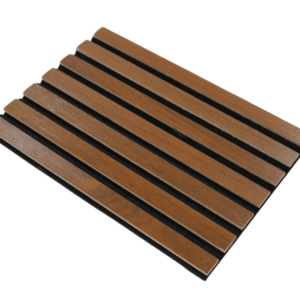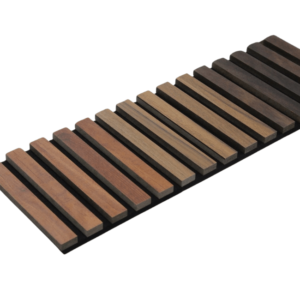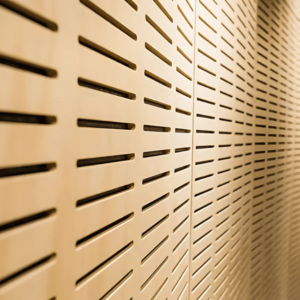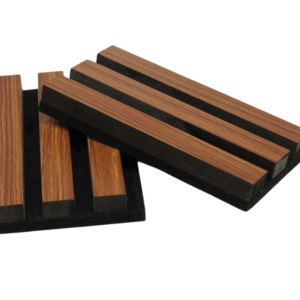High-Absorption Wood Perforated Acoustic Panels
Achieve high sound absorption economically with Wood Perforated Acoustic Panels from Gitco-sa.com. Combining natural wood aesthetics with precision perforations for superior acoustic performance.
Description
Wood Perforated Acoustic Panels available at Gitco-sa.com are the ideal choice for cost-effectively achieving exceptional sound absorption in various spaces. These panels masterfully blend the natural beauty of wood with the high acoustic performance derived from precisely engineered perforations. Customers can choose from diverse finishes (Melamine, Veneer, Painted), patterns, and hole diameter customizations to perfectly meet their unique acoustic requirements.
Constructed with MDF cores (Standard, Fire-rated, or moisture-resistant) and backed with 50mm mineral wool for optimal absorption, these panels are available in thicknesses of 12mm, 16mm, and 18mm. Standard size is 600x600mm, with optional sizes including 600×1200, 517×1381, 517×2400, 517×1200, 2400×1200, 1200×300, 2400×600, 1200×60, 197×2400, 293×2400, and 197×1381 mm. With a density of 700 kg/m3 and a flammability rating of B-s2 d0, these panels offer both performance and safety. Installation is straightforward for walls using Omega metallic profiles, clips, or wood battens, and for ceilings using standard System T24 or clips.
Key Features of Perforated Acoustic Panels :
- Effectively reduces reverberation and echo
- Low formaldehyde emissions and moisture-resistant options are available
- Highly aesthetic with various wood finishes and perforation patterns
- High-impact resistance for durability in high-traffic areas
- Better speech intelligibility for clear communication
- Washable and recyclable, contributing to sustainable building practices
- Easily installable on both walls and ceilings
- Highly sustainable material options
Understanding Wood Perforated Acoustic Panels:
- What are wood perforated acoustic panels?
- They are decorative wooden panels with precisely drilled or punched holes (perforations) designed to absorb sound waves and improve the acoustic environment of a room.
- How do wood perforated acoustic panels work?
- Sound waves enter the perforations and are then absorbed by acoustic insulation material (like mineral wool or acoustic felt) placed behind the wooden panel. The size and density of the perforations influence the frequencies absorbed.
- What are the benefits of using wood perforated acoustic panels?
- Improved sound clarity (reduced echo and reverberation), enhanced speech intelligibility, noise reduction, aesthetic appeal with various wood finishes and perforation patterns, and design flexibility.
- Where are wood perforated acoustic panels commonly used?
- Auditoriums, theaters, recording studios, broadcast studios, conference rooms, classrooms, offices, restaurants, home theaters, and multi-purpose halls.
- What materials are wood perforated acoustic panels made from?
- Typically a core material like MDF (Medium-Density Fiberboard) or plywood with a real wood veneer, laminate, or melamine finish. The acoustic backing is usually mineral wool, fiberglass, or acoustic felt.
- What are the different types of wood perforated acoustic panels?
- They vary in perforation size (diameter), perforation pattern (e.g., round, square, slotted), perforation density (spacing between holes), panel thickness, and wood finish.
- What are the standard sizes of wood perforated acoustic panels?
- Common sizes include 600x600mm, 600x1200mm, and larger panels up to 1200x2400mm or more. Custom sizes are often available.
- How do wood perforated acoustic panels affect the acoustics of a room?
- They primarily absorb mid to high-frequency sounds, reducing reverberation time and improving sound clarity. The specific absorption characteristics depend on the perforation design and the backing material.
Selecting and Specifying Wood Perforated Acoustic Panels:
- How do I choose the right wood perforated acoustic panels for my space?
- Consider the room’s size and function, the types of sound issues present, the desired aesthetic, and the required Noise Reduction Coefficient (NRC) or sound absorption coefficient for the space.
- What is the perforation rate or percentage?
- This refers to the ratio of the area of the perforations to the total area of the panel, usually expressed as a percentage. A higher perforation rate generally leads to greater high-frequency absorption.
- How do I calculate how many wood perforated acoustic panels I need?
- This depends on the room’s volume, existing sound-absorbing materials, and the target reverberation time. Consulting Gitco team is recommended for accurate calculations.
- Can wood perforated acoustic panels be used on walls and ceilings?
- Yes, they are suitable for both wall and ceiling applications.
- What are the different mounting options for wood perforated acoustic panels?
- They can be installed using screws, clips, or adhesive, often onto a framework or directly to the substrate. Concealed mounting systems are also available for a seamless look.
- Are wood perforated acoustic panels fire-rated?
- Fire-rated options are available, often using fire-retardant core materials and finishes. It’s crucial to verify the fire rating certifications for your specific project requirements.
Installation and Maintenance:
- How are wood perforated acoustic panels installed?
- Installation typically involves creating a level framework or using direct fixing methods, ensuring proper alignment and spacing between panels. Gitco Professional installation is often recommended for optimal results and aesthetics.
- Can I cut wood perforated acoustic panels to size?
- Yes, they can be cut using appropriate woodworking tools, but care should be taken to avoid splintering and to maintain the integrity of the perforation pattern near the cut edges.
- How do I clean and maintain wood perforated acoustic panels?
- Regular dusting with a soft, dry cloth is usually sufficient. For light stains, a slightly damp cloth can be used, followed by immediate drying. Avoid using excessive moisture or harsh chemicals.
Purchasing and Cost:
- Where can I buy wood perforated acoustic panels?
- They are available from specialized acoustic material from Gitco.
- How much do wood perforated acoustic panels cost?
- The cost varies depending on the core material, veneer or finish, perforation pattern and density, size, and acoustic performance. Prices can range from mid-range to high-end.
- Can I get custom wood perforated acoustic panels?
- Yes, many Gitco offer customization options regarding perforation patterns, sizes, finishes, and acoustic performance characteristics to meet specific design and acoustic requirements.
Enhance the acoustics and aesthetics of your space with Wood Perforated Acoustic Panels from Gitco-sa.com. Explore our wide range of customizations and find the perfect solution for your project.
Additional information
| Applied on | Ceiling, Wall |
|---|---|
| Material Type | WOOD |
| Core | MDF Standard | MDF Fire rated | MDF Moisture Resistant |
|---|---|
| Absorbent | Mineral wool (50mm) |
| Thickness | 12 mm | 16 mm | 18 mm |
| Finishes | Melamine, Veneer, Painted |
| Sizes | Standard: 600×600 Optional : 600×1200, 517×1381, 517×2400, 517×1200, 2400×1200, 1200×300, 2400×600, 1200×60 197×2400, 293×2400, 197×1381 mm |
| Density | 700 kg/m3 |
| Flammability | B-s2 d0 |
| Installation | Walls: Omega metallic profiles, Clips, Wood battens Ceilings: Standard System T24, Clips |
Perfero Series – Type 1
| Absorbent (plenum) |
125Hz | 250Hz | 500Hz | 1KHz | 2KHz | 4KHz | NRC |
|---|---|---|---|---|---|---|---|
| 50mm | 0.20 | 0.60 | 1.00 | 0.90 | 0.55 | 0.55 | 0.75 |
| 200mm | 0.45 | 0.90 | 0.90 | 0.90 | 0.65 | 0.55 | 0.85 |
Perfero Series – Type 2
| Absorbent (plenum) |
125Hz | 250Hz | 500Hz | 1KHz | 2KHz | 4KHz | NRC |
|---|---|---|---|---|---|---|---|
| 50mm | 0.13 | 0.75 | 0.39 | 0.29 | 0.16 | 0.07 | 0.40 |
| 200mm | 0.75 | 0.55 | 0.44 | 0.36 | 0.19 | 0.08 | 0.45 |
Perfero Series – Type 3
| Absorbent (plenum) |
125Hz | 250Hz | 500Hz | 1KHz | 2KHz | 4KHz | NRC |
|---|---|---|---|---|---|---|---|
| 50mm | 0.05 | 0.74 | 0.97 | 0.83 | 0.69 | 0.34 | 0.80 |
| 200mm | 0.56 | 0.86 | 0.72 | 0.89 | 0.76 | 0.42 | 0.80 |










Reviews
There are no reviews yet.